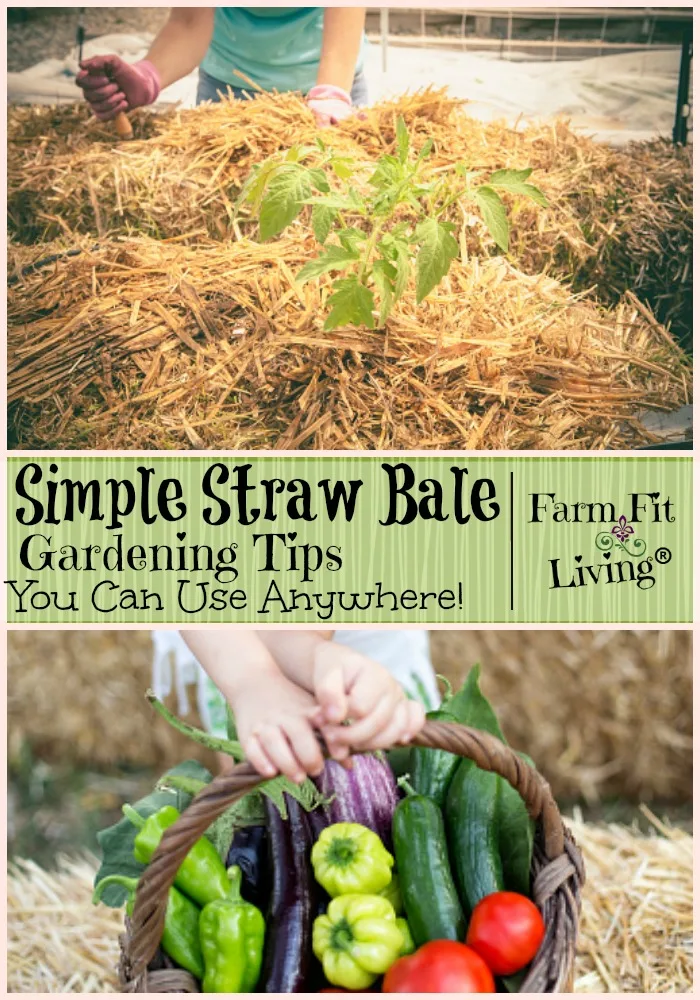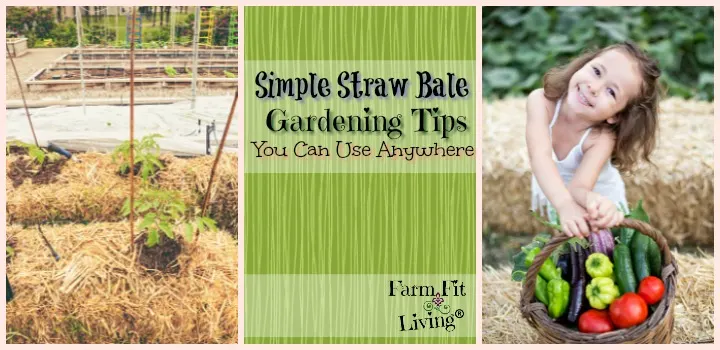Have you considered straw bale gardening as a container method?
There’s lots of amazing ways to have a garden even if you don’t have land. There’s container gardening, raised beds or rented space. And then there’s straw bale gardening.
Straw bale gardening is sort of like raised beds. There’s a few more benefits to this method, such as the ability to be incorporated back into the soil. It’s also very low-maintenance, which I know both you and I are looking for these days.
For more low-maintenance gardening tips, go here.
You can use small square straw or grass hay bales for this method of gardening. Just whatever you have or can get your hands on.
In this post, I will introduce:
- The ins and outs of straw bale gardening.
- Tips for growing vegetables in hay and straw bales.
- Lots of simple gardening ideas and tips for this method of gardening.
- How this method can help your health and spacing requirements.
Place bales anywhere
If you’re low on space for a garden on your property, growing vegetables in hay or straw bales could be just what you need. You can place these bales anywhere! Wherever they can get sun or maybe partial shade for whatever you’re growing.
Straw bale gardens can grow on any surface, including concrete and any soil type. This also eliminates the need for testing and amending soil.
Once you pick the place to put them, that will need to be their permanent home because they will break apart. Here’s some tips for holding them together through the season:
- Position bales with the cut side facing up.
- The strings need to be on the sides and the folded end of the straw on the ground.
- If you place your bales on unpaved surface, put several layers of newspaper of cardboard down first to keep weeds from growing up through them. Then, you shouldn’t have a weed problem!
Here’s some more tips for weed control
Best Plants for Straw Bale Gardening
Any annuals will work great for this method of properly prepared garden. Remember, annuals are plants that die at the end of the season and do not come back again.
The reason perennials do not work is because bales decompose, so chances are you’ll eventually lose your bale.
So, really, there’s lots of possibilities for annual plants to work. Popular choices for straw bale gardening include:
- Tomatoes
- Potatoes
- Peppers
- Annual Herbs
- Squash
- Greens
- Cole Crops
For a list of companion plants, go here.
If you have plants growing tall, such as tomatoes and peppers, you can use cages or build a trellis support system for them easily with t-posts and baling twine.
For a DIY trick to staking young tomato plants with baling twine, go here.
Here’s a tutorial for building a DIY trellis for any veggie.
Fertilizing the Bales
There’s a time line for optimum results that starts two weeks prior to planting anything into your straw bales.
Conditioning the bales is first and it expedites decomposition within the bales to create an optimal environment for root growth. Here’s how to do it:
- Sprinkle 1/2 cup of Nitrogen fertilizer (3 cups if organic) over the entire top surface of the bales. Water thoroughly.
- The very next day, water thoroughly again. And repeat fertilizer/water process for the next 6 days.
- On day 7, reduce the amount of fertilizer by half. Apply daily for three days watering each time.
- Finally, on day 10, add 1 cup (3 cups organic) of any 10-10-10 fertilizer.
So, the total time for conditioning (fertilizing) the bales equals 10 days total.
You’ll also need to monitor the internal temperature of the bale. Have you read my post about proper soil temperature?
If not, you can read that post here.
After day 12 and when the internal temperature is more than 100 degrees F, you’ll be ready to plant seeds or transplants.
Planting the Bales
You can plant seeds or transplants into the bales. There are some specific steps to follow here.
For transplants:
- Dig a hole in the top of the bale.
- Add a sterile planting mix.
- Then, place your plant in the hole and fill around it will planting mix.
For seeds:
- Cover the surface of the bale with a 2-3 inch layer of potting mix.
- Spread seeds over the soil.
- Cover with potting mix to depth recommended by your seed packet.
Following planting directions is important. Luckily, I have printables that you can download and print easily to take to the garden with you for row spacing and planting depth:
You can find both of them here about garden layout and spacing.
Watering the Bales
Spray bales directly with a hose or use soaker hoses.
I really love soaker hoses because I know the water is going directly into the bales. Also, when you have plants and the temperature is hot and dry, proper watering is important for the health of the plants.
Harvesting Your Fresh Produce
There aren’t any different methods for harvesting produce in a bale garden. It’s the same as any other garden.
You’ll find that root crops, such as potatoes, will rise to the top and you can just pull them out. And, of course, vine and stem crops can be easily seen and plucked or cut when ready to enjoy.
Easy harvest is just the icing on the cake for these simple gardening ideas using straw bales. Here are some more reasons you might want to try this method of gardening.
Pros for This Method of Gardening
There are a couple of benefits to using this method of gardening:
- The height of the bales appeals to gardeners who have trouble kneeling or bending over.
- Straw bales decompose through the season creating a nutrient rich environment.
- Clean vegetables at harvest time!
These are the most common pros for straw bale gardening. The only real disappointment is that the bales decompose eventually, leaving you to start over again.
Simple Gardening Ideas
And the most important pro for gardening in straw bales, in my opinion, is that it’s simple. You truly can do this anywhere and everywhere you want to.
If you’re looking for a container garden method but don’t have an actual container, then try growing vegetables in hay or small straw bales. Again, you can also use this with grass hay.
And again, properly conditioned and planted bales present fewer weeds and pests than traditional gardening practices. Straw bale gardening is truly is a low maintenance practice that you can enjoy season after season.


Make Gardening Simple Now!

Simple gardening equals smart gardening. In this short, easy to read book, you'll get access to all the best practices and tips for gardening smarter and more successfully. If you want more information, I'll send it right to your email inbox!



